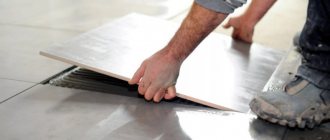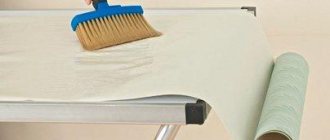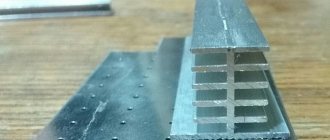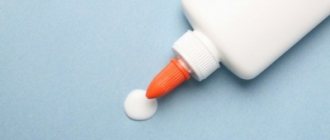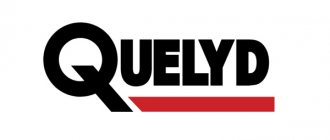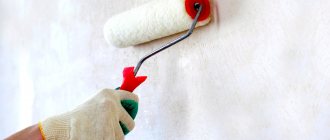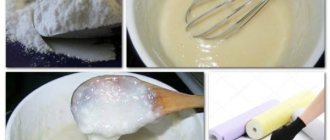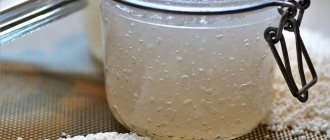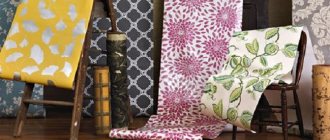Often wallpapering in an apartment ends with a mass of stains from diluted glue on the surface. Of course, it is very important that the sticker process be carried out as carefully as possible, but no one is immune from such mistakes. Glue stains are especially noticeable on dark wallpaper, so it is best to carefully monitor the cleanliness of the front side of the coating and immediately remove traces of dropped glue with a damp sponge before it dries completely. But even for already dried stains, there are several ways to remove stains from wallpaper, but their use must be very careful, and it is better to first try the chosen method on an inconspicuous area.
Reasons for the appearance of glue stains on wallpaper
Unfortunately, it is not always possible to avoid such a problem as the appearance of glue stains on the surface of the wallpaper.
Stains can occur if, before gluing, the wall was not properly prepared for the new coating, that is, glue residues from previous paintings were not removed. In the case of plasterboard walls, complete puttying is required. Also, putty is indispensable if the wall has lime stains. This substance can react with wallpaper glue and cause yellow spots on the finished covering that cannot be removed in any way. The walls must be completely ready for wallpapering, that is, covered with a primer and puttied. It is imperative to wait for the applied ready-made solutions to dry completely, so that stains and unnecessary smudges do not appear in the future. Sometimes a situation may arise that results in a reaction of an old, not completely removed substance with a new one. To prevent this from happening, the walls must be cleaned as thoroughly as possible from the old coating.
When covering a room with non-woven wallpaper, only the walls need to be covered with diluted glue; the canvases do not need this. This way, the wallpaper will adhere tightly to the surface and there will be no excess adhesive.
Usually, if the canvas does not stick well and begins to peel off, many people add more glue. But the point here, most likely, is a violation of the dilution technology, and not how much glue is on the sheet. Prepare the glue strictly according to the instructions from the package in slightly warm water, all lumps must be thoroughly mixed. The diluted glue is left to swell for several minutes. You should also not forget the fact that wallpaper glue is not stored for a long time, so you should not dilute it so much that it will not be possible to use it at one time. Later, its quality characteristics and adhesive qualities will no longer be the same as before.
Also, peeling wallpaper may be due to improper conditions of the room in which the renovation is taking place. Draft, direct sunlight and too low a temperature prevent the glue from setting.
Advice! For measured application, it is best to use a brush with a wide base and natural bristles.
How to avoid stains
In order not to damage the walls when gluing and to avoid the appearance of stains, you should follow simple recommendations:
- coating of canvases should be carried out in an even layer, without excessive excess;
- It is important to wipe the area where the glue is applied with a damp sponge after processing each sheet to avoid contamination;
- Having glued the canvas and carefully straightened it, wipe off the exposed glue;
- For strong setting, the room must be at room temperature, without drafts.
By listening to simple tips, it is easy to avoid unpleasant surprises and make the repair process high-quality and enjoyable.
Removing dried glue
It is almost impossible to remove the glue that remains on the seams and has dried. But it is very shiny and stands out, especially on dark wallpaper. First, you need to understand whether the problem is that critical before taking action. It is also worth determining the surface of the canvas in advance, since its very delicate structure will allow you to remove the hated stain.
There are situations in which removing the glue is simply necessary. This:
- Stains on very dark wallpaper where it stands out the most.
- Spots in those places where the play of color emphasizes their shine and the difference in shades of the canvases.
- An elite renovation that simply cannot contain such flaws.
Modern heavy wallpaper can be wet cleaned, the main thing is to always follow the instructions.
Wet cleaning of glue
Those fabrics that do not raise doubts about the possibility of wet processing can be moistened with warm water from a spray bottle. Wet areas should be left for 10 or 15 minutes, and then lightly wiped with a soft cloth. This method is ideal for dealing with starch-based glue that has not completely dried.
If a diluted starch-based adhesive was used, clear vinegar with a concentration of 9% can be used for cleaning. It reacts with starch and destroys its structure. As a result, the stain quickly disappears.
Another option for removing modified starch-based glue is this: the dried glue is covered with a paper napkin, and a small amount of window and mirror cleaner is sprayed on top. The mixture is kept for 15 minutes, after which the napkin is removed and the treated area is blotted with a dry paper towel. The wet area should dry on its own, never in a draft or under the influence of a hairdryer.
Important! PVA glue can be removed using warm water, to which you need to add vinegar or vodka.
Non-woven wallpaper can often be cleaned even with a brush; this is indicated on the packaging in the form of three waves and a brush. But first you need to try wiping them in an inconspicuous place with a damp sponge using a non-aggressive detergent. If you managed to remove the stain, but the canvas has not lost its previous appearance, then this cleaning can be applied to other stains.
Dry removal of glue
This method can only help in exceptional cases, so you shouldn’t rely too much on it. First you need to inspect the glue stain for peeling and peeling. If this is the case, then you need to take a soft-bristle brush and a sponge with an abrasive surface. To completely exfoliate, rub the stain with a brush and then with the hard side of a sponge. As soon as the dry glue is removed, you need to wipe the treated area with a dry cloth. It will remove small remaining particles.
If after treatment the stain does not disappear or does not disappear completely and the coating is not damaged, then the treatment can be repeated until the stain is completely removed. How long you need to rub depends on the strength of the glue.
Removing glue from wallpaper is not a very difficult task, but you need to see in advance whether it is really worth doing and evaluate all the risks. Sometimes cleaning can lead to disastrous results and the need to change the coating. But, if you still cannot do without it, then you must do it according to the rules and strictly adhere to the work algorithm. It is best to follow all the rules when carrying out repairs (no drafts, wiping the surface, etc.) so that you don’t have to worry about removing stains later.
- Liquid glass and its application
- How many boards in a cube
- Fiberboard or hardboard
- DIY bark beetle plaster
Alternative cleaning methods
If starch adhesive is used when gluing the canvases, the stains can be treated with nine percent vinegar, which can dissolve them. In such a situation, you can also use a glass cleaner, which is applied to the stain and left for 15 minutes. It is removed along with the soaked glue with a dry cloth.
Important! The entire area near the contamination is covered with masking tape for the duration of such treatment.
If the wallpaper is glued to a PVA compound, you can soak it with a cleaning agent, vodka, or scrape it off with the abrasive part of a dishwashing sponge. It is better not to carry out such manipulations immediately in an open place.
During the process, it is important to ensure that the composition soaks, without deteriorating the surface of the wallpaper, and after work, the treated area remains the same as before. There are situations when wet wallpaper after cleaning looks the same as before, but as it dries, it loses its decorative appearance. That is why it is important to check how the coating will behave after drying.
Before cleaning wallpaper, be sure to read the markings on the rolls. Thanks to them, you can determine how much the fabrics are afraid of moisture, how they react to external influences, and what cleaning methods they can be subjected to.
How can I remove glue from wallpaper?
When gluing wallpaper, you need to be very careful and follow the recommendations for preparing the walls for all stages of work. If excess glue appears at the joints, you must completely remove it from the wallpaper with a damp cloth and do not wait until it dries. If the surface is already dry, then there are several ways to remove glue from the wallpaper. They can be applied with care. To remove glue residue, you can try wet wipes, which effectively remove any dirt. If this does not help, then you should carefully proceed to other methods.
You need to remove glue from the wallpaper directly during gluing, without waiting for it to dry.
But it is best to avoid such mistakes. Nowadays there are many wallpaper adhesives on sale that do not leave stains on the joints. When purchasing and using these types, you don’t have to worry that the work will be ruined by stains from the hardened adhesive solution. There is no need to buy cheap wallpaper adhesives, which leave yellow spots on the wallpaper and do not ensure good wallpaper glide when pasted. It is not recommended to purchase those formulations that do not have an inscription stating that the proposed substance does not leave stains when dried. It can be assumed that the manufacturer did not indicate this important information for the consumer, because this side effect is present in the composition of the substance and such products tend to leave untidy stains that change the basic color of the wallpaper.
By following the rules for wallpapering walls, you can get rid of the need to find a way to remove glue that should not be on the front side.
Pasting without stains
Typically, wallpaper glue has a transparent composition, so it is practically invisible. But under certain lighting, stains can still be seen on the wallpaper if they occurred during pasting. It is important to remove glue from canvases when it is still fresh and has not dried. Wallpaper glue usually comes off quickly. And if you carry out the procedure immediately after the stain appears, then it will be completely simple.
To decorate a room with high-quality wallpaper, during the work you must follow some rules:
- Monitor the cleanliness of the surface on which the canvas is treated with glue.
- Spread enough glue on the wallpaper so that when pressed against the wall it does not squeeze out onto the front side of the canvas. It is recommended to lay a film on the floor to protect the decorative side of the wallpaper from glue.
- After pasting, all walls are blotted with a dry, clean cloth.
It is worth remembering that when removing glue, it is necessary to take into account the type of wallpaper that is used for pasting. So, for example, paper sheets cannot be cleaned of dried glue, since they are thin and have good moisture absorption. Any manipulation on such capricious canvases can lead to irreparable results.
Methods for cleaning glue stains
You can remove glue stains using an anti-glue product.
When working with an adhesive composition whose manufacturer has not stated that the product does not leave stains, you should remember that it is very difficult to remove glue from wallpaper after it has hardened. When such a substance dries, it does not wipe off, but remains, and after a while it may turn yellow or become moldy. Even a stain of paste, the most primitive means for gluing wallpaper, is very difficult to wipe off after hardening. The glue, cellulose or made from polyvinyl acetate, cannot be removed because after the polymerization process it does not dissolve in either water or alcohol. If you try to soak the stain so that it swells, you can ruin the whole job.
You can test the effect of a chemical substance in an inconspicuous place. It is suitable for removing instant glue, PVA, polyurethane-based contact adhesives, as well as label marks, ink and marker stains. This chemical may dissolve the surface when applied. Therefore, when using it, you need to be careful and test it before using it. The instructions tell you how to remove frozen drops of adhesive from the surface. It is applied to the contaminated area and left for 60 minutes. After waiting the required time, wipe the treated area with a dry cloth and wash in soapy water.
If this remedy does not help, then all that remains is to put up with the stains or disguise them. Hang a decorative plate or some object in this place and cover it with furniture. If this option does not suit you, then the wallpaper should be re-glued.
How to remove wallpaper glued to bustilat
Previously, very strong adhesives such as bustylate were used for repairs. Therefore, during repeated repairs, it can be difficult to tear off the glued materials. This is often encountered when installing new wallpaper.
Old wallpaper is very difficult to remove from the walls; it is usually glued to a layer of newspapers and bustilate, so it is very firmly attached to the surface. To remove all this “layer cake” it is best to stock up on a special tool for removing the old layer. It will be difficult to remove high-quality wallpaper, so be prepared for lengthy work.
What should you buy?
- Metal spatula or scraper.
- Sprayer and foam sponge.
- Polyethylene film.
- Chemical solvents or strippers.
- Wire brush.
- In addition, a stepladder, tape, water and detergent, and even an iron will come in handy.
There are several ways to remove wallpaper glued to bustilate.
Choosing methods of work
- Mechanical removal.
- Maceration.
- By heating with an iron.
- Partial removal of the top layer.
It all depends on how the wallpaper was glued to the wall or ceiling. If it is on a layer of newspapers, then it is much easier to remove, and you just have to gradually peel them off along with the newspapers from top to bottom using a spatula. To avoid staining the floor, cover it with plastic wrap, attaching the upper part to the baseboard and spreading the lower part on the floor.
Difficulty removing
If you cannot completely remove the wallpaper, you can try to wet it. To do this, the glued wallpaper is scraped with a metal brush and moistened with a sprayer and sponge. The water must be hot, and for better results you can add detergent.
Don't wet too much surface area; it will dry out quickly and you won't have time to remove all the layers. Don't forget to turn off the electricity when working, because you will be removing wallpaper near electrical outlets. You can seal them with tape while the work is being carried out.
After wetting the surface, wait until the water is absorbed. Then, after 15 minutes, try pulling the top layer; it should come off the walls more easily. To remove bustylate, you can use special chemical solvents or removers; they will help remove the layer of glue from the walls. A special wallpaper remover helps to quickly remove the old coating.
To completely remove bustilate from the surface, you will have to use a scraper, sandpaper and other tools, the entire list of which you can see in the photo.
The thicker the wallpaper, the more difficult it is to remove. So, with vinyl, it is often possible to remove only the top layer, and the bottom layer is almost impossible to remove, so many people use it as a basis for gluing new wallpaper. Bustilate is not removed, but remains below the top new layer.
How to remove glue from wallpaper?
Before removing the glue, you need to moisten the wallpaper with a spray bottle.
Practice shows that excess glue that was not removed from the seams immediately can hardly be removed after drying. But you can try to get rid of them. The stained areas on the wallpaper shine and differ in color. You can try to remove them by spraying them with warm water and leaving them for a few minutes. After 10-15 minutes, carefully wipe the contaminated area with a soft cloth. This may help if the strip is still fresh, has not completely dried out, and the substance was created based on modified starch. Stains from this type of adhesive can be removed using colorless 9% vinegar, which interacts with starch and promotes its rapid dissolution.
Non-woven wallpaper has a very high degree of resistance to mechanical stress, and you can try to clean it. If the wallpaper label had symbols such as three waves and a brush, this means that it is moisture resistant and can be cleaned mechanically. Don't immediately start scrubbing them with a brush. First, rub in an inconspicuous place with a damp sponge using some detergent dissolved in water. If the stains disappear and the wallpaper does not dissolve in water, then the operation of cleaning the remaining adhesive base can be continued.
If the product was created on the basis of modified starch, it is worth trying to remove contaminants in the following way.
Cover the dried surface with a paper towel and spray the material with a glass and hard surface cleaner. After 10-15 minutes, everything is removed, and the treated area is blotted with a dry paper scarf or towel.
PVA stains are washed with warm water and treated with vinegar or vodka.
How to use Anti-Glue?
The product is applied in a thin layer to the glued or glue-stained material. For a better reaction, you need to leave the product for several hours - the anti-glue penetrates into the glued areas and destroys the connection. The remaining gel is thoroughly washed off with soap and water.
Interesting materials:
Is it possible to wash a pen from clothes? Is it possible to boil champignons? Is it possible to transfer units from kcell to asset? Is it possible to move objects with the power of thought? Is it possible to move the kitchen into the living room? Is it possible to move the walls in the bathroom? Is it possible to replant trees in October? Is it possible to replant gooseberries in summer? Is it possible to replant flowers in January? Is it possible to replant thuja in the spring?
Why might glue stains appear on wallpaper?
Glue stains are easily removed using folk remedies - vinegar or vodka.
Stains may appear if the wall was not properly prepared for work. The wall must be cleaned of all remnants of glue remaining from the removed wallpaper. If the wall is made of plasterboard, it must be puttied. A surface that has lime stains on it needs putty. They can interact with wallpaper paste and appear as yellow spots that will be impossible to remove.
The wall, ready for work, must be perfectly clean, coated with an antifungal primer, and puttied. You cannot glue wallpaper on a wall that is not dry. This can also cause stains, which are attributed to poor-quality adhesive. Sometimes stains are caused by a chemical reaction between the old substance and the primer and the new adhesive. To prevent this from happening, the walls must be washed very carefully from old wallpaper.
When using a high-quality product, stains from excess glue that was not removed in time may also remain if a large amount was applied during the work.
Scheme for correct application of glue to wallpaper: 1. Spreading the canvas with paste. 2. Fold the canvas in half.
When working with non-woven wallpaper, you do not need to apply glue to it. They only treat the wall, and this is enough for the panels to attach well to the wall. When the wall is treated evenly, excess glue is removed with a wet, clean rag.
Surpluses appear only when there is an excess. Sometimes the wallpaper doesn't stick well, and then they start adding too much glue. But the reason may not be the glue at all, but a violation of the technology for diluting it. It must be prepared strictly according to the instructions, in water at room temperature, avoiding the formation of lumps.
When applying the adhesive solution, it is most convenient to use a wide natural bristle brush. Then the solution will lie evenly, and there will not be too much of it.
If you start working with paper wallpaper, then when distributing the adhesive onto the cut pieces you should be extremely careful and not allow it to get on the front side. And if this does happen, the glue is immediately removed with a clean, damp cloth.
If too much of this substance gets on the front part, then it is better not to use the damaged sheet than to worry about the stain appearing on the wall later.
How to hang wallpaper without leaving traces
When starting work without the help of professionals, be patient, adhere to the gluing technology, and promptly remove excess glue at the joints of the canvases.
Dried glue stains are much more difficult to clean; it is possible that the stains cannot be washed off.
When dealing with thin paper wallpaper, streak removal operations must be carried out carefully so as not to damage the surface of the canvas. The paper material is delicate, sudden movements will ruin all the work done. You can start after a small test from below, wipe the composition with a damp cloth.
To avoid problems, you should take a responsible approach to choosing glue. To do the job well, you need a special adhesive with the necessary properties and efficiency, do not spare money. Remember that apartment renovations take years to complete.
The special wallpaper composition of the adhesive substance, when dry, will save you from erasing and washing. The glue is invisible, so when buying a product, make sure it says what it says. The packaging must clearly state that the adhesive does not leave residue.
How to dilute glue correctly
Having previously prepared all the tools, you should carefully read the instructions for diluting the adhesive mixture, which is always on the package. Using the instructions, you can determine the amount of water required for dilution. For each type of wallpaper, the thickness of the adhesive mixture is different. If placed incorrectly, there is a risk that heavy wallpaper will simply fall.
Preparation of wallpaper glue:
- Pour the required amount of water at a certain temperature into a plastic container. What temperature it should also be indicated in the instructions on the package.
- Using a stick, we form a funnel in a circular motion and begin to gradually add the adhesive mixture in small portions. This should be done very carefully to prevent the formation of lumps. They are very difficult to get rid of. Therefore, it is better to do everything right from the beginning.
- Stir the solution until the mixture is finished. Then for another 10 minutes. After this, leave the solution to swell for 15–20 minutes. After this time, mix thoroughly again and begin the process of wallpapering.
When preparing the adhesive mixture and the process of gluing the canvases, you need to follow a few tips:
- Dilute glue only in accordance with a certain type of wallpaper. For heavy ones it should be thicker.
- It is better to make the glue mixture a little thicker. In this case, it can be divorced. If the solution is liquid, then making it the desired consistency is much more difficult than diluting a thick one.
- Do not add dry mixture to already diluted glue. It is necessary to dilute the remaining mixture separately, and only then combine both solutions. In this way, prevent the formation of lumps.
- Try to use the diluted wallpaper glue within a few days. It cannot be stored for a long time. It begins to very quickly lose its unique properties. The adhesive mixture can remain unused for up to ten days. But it is recommended to store it in a cool place. Ideally pour into a glass container and refrigerate.
- If you purchased glue in a vacuum-packed bucket, its shelf life is three months. If a longer period is indicated on the packaging, it means that such an adhesive composition contains harmful additives. It is not recommended to use such a solution, as it is hazardous to health.
- A draft is very harmful for freshly pasted wallpaper. Therefore, try to carry out work with the windows closed. When there are drafts, the temperature in the room is unstable and this factor affects the properties of the glue.
Effective ways to remove fresh glue
When gluing walls with heavy wallpaper, a thick adhesive composition is mainly used, which is why it is extremely rare to prevent its protrusion at the seams. In such a situation, while the glue is in a liquid state, you need to proceed as follows:
- The first step is to wet a clean rag in warm water and then wring it out well.
- Next, use a damp cloth to remove the glue from the wallpaper in a circular motion. From time to time it is necessary to re-wash the rags.
- It is necessary to carry out actions in the same way until the stains are completely removed.
Hardened glue, as mentioned earlier, is somewhat more difficult to deal with, but you can also try to remove it. Initially, you should find out the texture of the wallpaper that needs to be removed. The more delicate the wallpaper, the more difficult it is to remove such stains.
It is mandatory to carry out a preliminary risk assessment regarding wallpaper cleaning. If the stain is visually inconspicuous, then it is better not to even remove it, avoiding the unnecessary risk of damage to the finishing material. This especially applies to thin paper trellises, the surface of which is very likely to be abraded by friction with a damp sponge.
How to remove adhesive stains
In principle, in almost all cases, the glue ends up on the front of the wallpaper. This happens when the wallpaper is smoothed. Excess glue is squeezed out at the joints. And if this is not visible immediately after completion of the work, then over time light whitish spots will form. This is especially noticeable on dark wallpaper. How to eliminate this kind of marriage? Let's consider two cases.
Preventing glue from getting on the wallpaper
Of course, it is much easier to remove contaminants fresh. Therefore, the sooner we start, the better the quality of work will be. This is achieved by wiping off splashes or excess glue with a clean, dry rag or sponge. The rag should be soft so that the outer part of the wallpaper is not damaged.
Important! It is always easier to carry out preventive work than to remove gross miscalculations later.
Therefore, it is necessary to carry out the work very carefully and carefully ensure that the glue does not get on the wallpaper surface. To do this, you must strictly follow the following recommendations:
- carefully ensure that the surface on which the process of applying glue to wallpaper sheets is carried out is always clean;
- Apply the glue evenly and avoid the formation of excess. The formation of excess always ends by squeezing it out onto the joints of the wallpaper strips;
- Immediately after gluing, you need to wipe the joints with a dry and soft sponge.
Removing fresh glue from wallpaper
If, however, it was still not possible to prevent the glue from getting on the wallpaper by absorbing it with a dry rag, you need to remove it. This kind of embarrassment most often occurs when walls are covered with heavy wallpaper. The consistency of the glue for such wallpaper is very thick and difficult to absorb with a sponge. So, to remove fresh glue from wallpaper you need to:
- A soft sponge is intensively moistened with warm water and wrung out well.
- Then gently wipe in circular motions in those places where glue particles have fallen.
Detergents
They are not recommended for use on single-layer paper wallpapers, as in this case they can be damaged. For all other types, it is recommended to moisten a sponge with a product (for example, dishwashing liquid), wipe the surface with it, and then rinse with water. This method is used only to remove fresh stains when the glue has not yet dried.
Yellow spots or liquid wallpaper
As a bonus, I would like to talk about liquid wallpaper, and about such a common problem as the appearance of yellow spots on it. Usually the reasons lie in a poor-quality primer that was applied to the wall before the wallpaper. In addition, the reason may be a poorly cleaned surface.
Such stains can be removed with the well-known white, which must be diluted in water on a scale of 1 to 3. In addition, stain removers are used for such purposes. Finally, yellow spots can simply be painted over by applying another layer of liquid wallpaper on top. So, when purchasing these finishing materials, it is best to take a little more than necessary.
How to wash paper wallpaper from grease, glue, ink, dirt, greasy food stains:
1. Try to carefully scrape off dried dirt with a soft brush. Then wet the sponge and use the rough side to very lightly brush off any remaining dirt.
2. Try to carefully erase traces of ballpoint pens, pencils, and crayons with a stationery eraser. In order for it to remove dirt better, first soak it in kerosene.
3. Press the crumb of fresh bread onto the greasy stain, repeat several times until the stained area is lightened.
4. You can also try to remove traces of fat with a piece of cloth soaked in gasoline. You can use a mixture of gasoline and tooth powder.
5. Stubborn food stains and other contaminants can be removed using a napkin and an iron. Apply the napkin to the stain, heat it slightly with an iron, repeat several times through clean areas of the napkin.
6. To remove stubborn stains that are not too deep, use a melamine sponge lightly moistened with soapy water.
When stains are a problem
The glue coming out of the seams of the wallpaper is not always noticeable. But in some cases this still happens. First of all, we are talking about dark wallpaper, where all the flaws in the joints are much more visible. And of course, such shortcomings are unacceptable for really expensive repairs. If the wallpaper cost you a fortune, then, of course, you don’t want to see traces of glue and other imperfections in the work.
